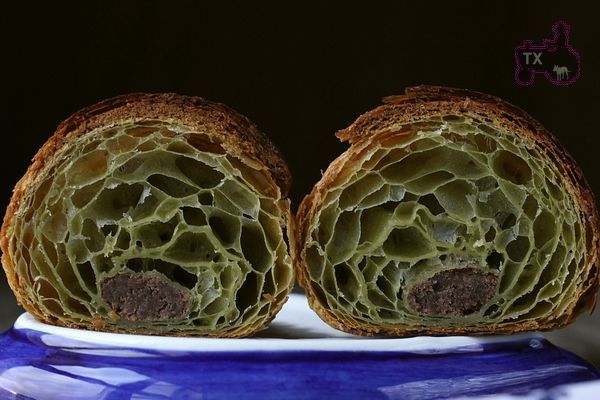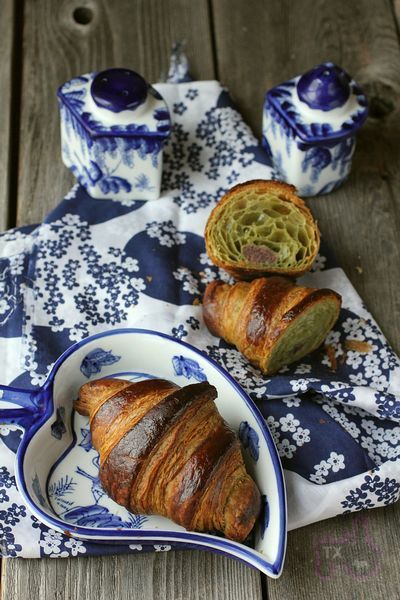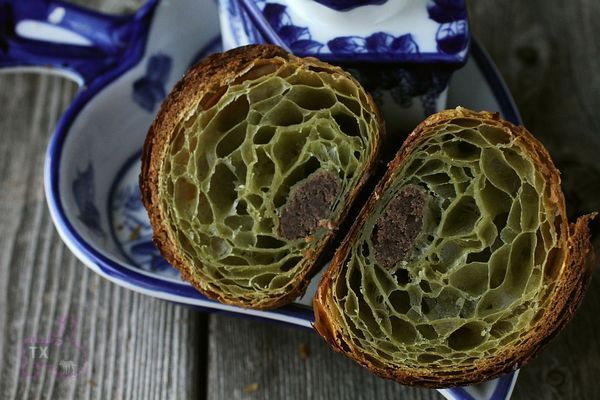Sending this toYeastspotting.
Click here for my blog index.

Haven't been blogging much lately, but actually baking a lot. Ever since I started making laminated breads, they have become my signature gifts to people. This batch is for some family friends. Since they are Chinese, I thought it would be nice to add some Asian elements -- mixed matcha powder into the dough, and used red bean filling for some.
Matcha Croissant with Sourdough Starter(Adapted from ABAP)
Note: for details and tips on making croissants, please see this post & this post.
Note: this recipe makes about 12 large danishes.
-levain
starter (100%), 35g
water, 59g
bread flour, 105g
1. mix and leave at room temp for 12 hours.
-final dough
bread flour, 422g
water, 148g
milk, 128g
sugar, 68g
salt, 10g
instant yeast, 7g
butter, 21g, softened
matcha powder, 16g
levain, all
roll-in butter, 287g
1. Mix everything but the rolling butter, knead until medium gluten developement. Then follow the steps here. 
Lately I got some question in terms of the "right" dough consistency of laminated breads. I have said in a few prior posts that "drier dough yields better crumb". Now I would like to emphasize 2 conditions for that statement:
1. "Better crumb" in my mind is honeycomb like crumb with open large holes of even size. Walls of holes should be crisp and thin, clearly defined. If a different kind of crumb is desired, then this technique obviously would not apply.
2. Drier dough yields better crumb IF IT CAN BE ROLLED OUT WITHOUT BUTTER LEAKAGE. Butter leakage here means butter being smeared into dough layers. In the most extreme case, one can see butter layer being exposed. More often, the dough seems fine from outside, but there's still butter leakage inside due to warm weather, or improper handling. A sheeter can roll out doughs easily in a short amount of time, so it can handle very dry doughs. We as human with limited arm strength and varied experience in lamination would need to find a balance point: the dough is not so dry that it can't be successfully rolled out, yet it should be as dry as one can handle to achieve the most optimal crumb.
For this batch, I used 148g of water (in addition to milk). The crumb turned out very well, however, observing closely, you can see the walls being on the thicker side -- some layers are stuck together.
For 2nd batch, I used only 128g of water (with no filling this time). Now the walls are thinner, however, since it's dryer and harder to roll out, the holes are less even.
I realize that I might be splitting hairs at this point, but it's a well known fact that I am a type A obsessed lamination fool. :P For the plain ones with no filling, I smeared them with homemade kumquat marmalade, a pairing I highly recommend.
- txfarmer's Blog
- Log in or register to post comments
Please meet green croissants and jam. ;)
Beautiful as always, txfarmer.
-
I'm tempted to start shaping them as you do. Just roll up the triangle of laminated dough and stop there, instead of trying to make them crescent-shaped, even if it blasphemes the history.
I read the following on internet (therefore it must be true :P)
" In France, it is the law, that only a croissant made with pure butter can be straight. If a croissant is made with any other sort of fat, for example, margarine, it must be joined at the ends to form a crescent moon shape. "
Since we are making pure butter croissants, apparently straight is the endorsed the shape?
That's too funny.
I always thought the crescent shape was something or other about the Ottoman turks defeat at Vienna.
Wikipedia! Your fail me yet again! (shakes fist!!!)
Wow, those are amazing. I bet they taste fantastic. I bow down to the matcha red bean filling croissant.
Matcha + dark chocolate could be quite grand too. And a little more accessbile to people.
Thanks! You are right, chocolate filling would be good too. Red bean filling in fact is not hard to make. Red bean (the small kind often seen at Asian markets) cooked until very soft, mash, stir in pot with lard/oil/butter and sugar, done.
These are the best looking croissants I have ever seen. Everything about them is just fantastic. Tea green open crumb with red bean paste is so alluring and tantalizing. It would take normal people the rest of their lives to make croissants like that and you bake them off like ho hum. You are one talented baker and its great just to be able to see your work. Now, if we could taste it......the end would truly be very near indeed :-)
Keep on baking on txfarmer!
Thanks Dabrownman!
Gorgeous symmetry in the crumb, txfarmer.
Simple ingredients - but requiring perfection in technique.
Thanks! Perfection in technique is such an elusive thing...fun to pursue though.
txfarmer,
Beautiful croissants. To me they are all stunning. I imagine you are making a lot of new friends in Seattle when you present these to people! Think maybe you should quit your 'day job' and become a professional baker.....but then that would probably take all the fun out of it!
Thanks for the update on your croissant sagas and the lovely photos.
Take Care,
Janet
Thanks Janet! You are so right, this is so fun I don't have the heart to turn it into a job.
Txfarmer...I echo the above comments. Maybe to you they are not perfect....but at least that will keep you baking them so we can share your masterpieces in the future!
Thanks for sharing with us envious croissant lovers!
Regards,
Ian
Thanks! I will keep baking them all right, still got more gift requests coming in...
Thanks Mebake!With croissant baking, initial failure is certain, one just have to keep trying, and trying, and trying...
I totally agree with you about how lower hydration dough for lamination gives better crumb. I also think it gives better flaky texture and better structure. (For me, lower hydration dough is when it stops being sticky but still easy to roll.) I tried dough that was soft and on the slightly hydrated side, they always end up being brioche-like, no flaky texture and the height is flat, even though the butter was always chilled. I think maybe the dough sheets were too moist to hold the structure. That's my guess.
I find with wetter dough, you need to knead longer to get the same structure.
Hey Txfarmer..keep up the good work, gorgeous croissants!
I work in a small startup bakery/patisserie in the bay area and I am currently working developing a croissant recipe.
Your croissants are beautiful, I am looking for an open and even crumbstructure. These croissants here are spot on! All hand rolled non the less, quite impressive!
I started with a base Pierre herme recipe and have been adjusting it, I do not have any real baking experience prior to this so everything has been trial and error for me. I was wondering, how tight you roll them when shaping? Also, whats the scaled weight before and after baking ?!
Keep the kickass croissants coming! ill have to get some pics up of mine, although they are not consistent enough and im still looking for a more open crumb!
Thanks!
The two earlier posts I quoted ( this post & this post) contains a lot of tips on how to achieve an open crumb, hopefully they might be of some help to you.
I roll them mediumly tight (I know, I know it's so vague). I stretch the tip while rolling from bottom. If you read the earlier posts, there are exact measurements on the triangle before rolling, and how much turns to roll, combined that would give you an idea how tightly it's rolled.
I honestly don't have exact measurement on the pre/after baking weights. This is the difference between home/professional baking I guess, I totally understand how such scaling would be essential for you. All I can say is that add up all the ingredients, minus some trimming, divided by 12, that would be the pre-baking weight for each croissants. In the earlier post, there are exact measurements on the size of the rolled out dough, it might be useful?
Txfarmer,
your croissants are piece of art! They are of extraordinarily visual beauty!
Thanks!
oh my god, these are amazing!!!! If you ever come to germany, please make a croissant workshop for us!!!
P.S.: you used 16 g of matcha tea? I wonder how much these croissant would cost each? 10 dollars :D
These croissants look absolutely fabulous! And the green color is a nice additional touch.
My brother is a big fan of all things japanese, including japanese tea. He also loves croissants, so this recipe immediately made me think of him. I'll have to bake some for him! :)
Txfarmer... what is the secret to prevent leakage which you mentioned in your original post? It is my thought that gluten development would be the key to controling leakage thus creating a bonded layer between the butter layers. Even if the dough was not tight (on the dry side), if the gluten was more developed would that be a key in preventing leakage (retaining layers)?
Oh, btw, outstanding croissants!!
Bill
Prevent leakage is not the same as retaining layers.
Key to prevent leakage is for butter not to melt, i.e. cold temp, frequent relaxation of the dough in the fridge.
Key to retaining layers is no leakage + strong gluten, so that 1) there are distinctivce layers and 2) the layers can have strength to expand into holes.
They are absolutely marvelous.